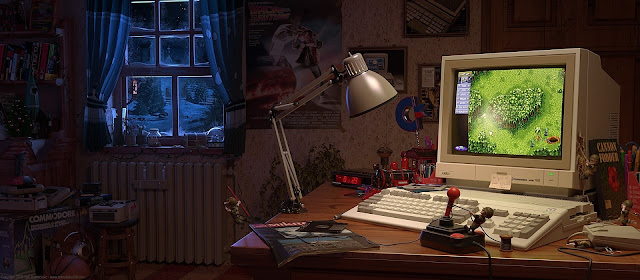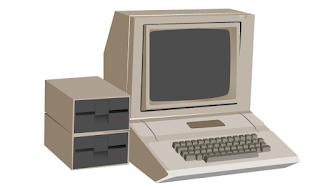Retro PC Gaming
I can
remember walking into a Game Shop as a kid and walking around,
looking at the games on offer for the various computers of the day.
There had been computers around for decades, but they were starting
to be available to have in the home. The Spectrum, the Dragon, the
Commodore 64, the Vic 20 and the BBC Micro. Not to forget the mighty
Amiga and Atari ST. There were games galore, some on cassette, some
on disk, and most were rather expensive, especially the big name
companies.
Sometime
later, the Personal Computer (PC) came into the price range of the
mainstream user, IBM did a deal with Microsoft and Windows became the
standard Operating System for the PC. Games started to get better as
the equipment got better, processors got faster, memory got better
and faster, graphics cards designed with gaming in mind were
appearing in shops, with their own dedicated memory on board.
I
remember the first PC I bought was a Packard Bell. The model? I don’t
remember. I do remember that it had 32mb of sd-ram (of which I did my
first upgrade to 64mb), 3.2GB HDD with a floppy drive and a 16 x
cdrom. The Operating System was Windows 98Se, and it had a Socket
Seven CPU with MMX. Lets not forget the ball mouse and massive 15”
CRT Monitor. It was a beauty!
I
eventually bought a PS1 for my daughter, and the multidisk had some
free games on it, such as MYST, broken sword and road rash. I liked
road rash, really liked broken sword, and was addicted to MYST. So
when the sequels came out, It was time to build a more powerful pc,
or get a PS2. What actually happened was that I did both, but the
majority of the PC builds I have done have been because my machine at
the time couldn’t do what I needed. Most of the time it was that I
needed something to run a rather demanding or resource hungry game.
The
best example that people can relate to is, of course, Crysis. This
game came out in 2007 and very few people had a machine good enough
to play the game properly. How many of you out there went to look at
a PC only to ask ‘will it play Crysis?’
Basically
Retro PC Gaming is going back to play these fantastic games, these
memories from our childhood, these wonderful arenas of digital
perfection. My first pick is always going to be Theif. I love this
game, The sequels, the fan made levels, the story and the journey it
takes you on. I bought the PS2 to play Metal Gear Solid, I built a PC
to play Monkey Island. I built another PC to play The Longest
Journey. It’s just wonderful!
So,
what is Retro PC Gaming all about, apart from the above, of course.
Well, it’s where you get to build that super computer or state of
the art gaming PC that you couldn’t afford back in the day. You
choose an era and run with it. You can choose a game and build a
machine to run it or you build the PC that you dreamed about building
ten or twenty years ago, sourcing the perfect parts from second hand
sales areas such as car-boot sales or e-bay.
Building
the machine is as much a part of the experience as the game playing.
Maybe you want to play old 8 bit games, on a Pentium 3 machine. You
want a couple of floppy drives. You want a 5 ¼” floppy drive and a
3 ½ “drive as well. Maybe you want a DAT tape drive, or you want
to run unix or windows 3.11.
Maybe
you want to build something from 1999 or 2000, running Windows Me or
XP or 2000, you want a specific board and a specific graphics card.
Basically,
the world is your oyster.
So,
you can make your project time specific and build a machine from the
80’s, 90’s or 2000’s. If you want to you can, of course, take
the modern route. This is basically where you get a modern PC or
laptop, or something that is a few years old, but still running
Windows 7, for instance, (but is capable of maybe running Windows 10)
and you install Emulators for what you want to play.
An
Emulator is basically a virtual machine, which runs the games that
the emulator is built for. For instance, if you want to run a DOS
game or an early Windows game, maybe Monkey Island or Broken Sword,
you could use a piece of software called ScummVM. ScummVM (Script
Creation Utility for Maniac Mansion Virtual Machine)is a set of game
engine recreations. Created in September 2001, it was originally
designed to play LucasArts adventure games that use the Scumm system,
it also supports a variety of non-Scumm games.
In
addition to this, you could use a virtual software such as VMWare,
and install an early version of Windows for game installation.
Other
examples of Emulation, are the console emulators such as MESEN NES
Emulator, CEMU Wii U emulator and the big one, which is MAME which
can Emulate Windows, macOS, Linux, BSD, Amiga, Megadrive, etc.
Emulation
has it’s place, but is not really considered as Retro PC Gaming,
there are many people on youtube that promote Retro and there are
forums on all social media networks.
On
Youtube check out LGR (Lazy Game Reviews), MetalJesusRocks, Modern
Vintage Gamer (but to name a few,
there are many more)
Your
probably wondering what machine I have for my retro games. Well, I
actually have a few, because building the machine is the main part of
the project, the game is the prize at the end, so to speak. So, I
have a Dell Optiplex SX260. A good example of finding a good use for
old tech. I had Tiny 7 on this thing for a while and a couple of
linux distro’s, but never felt it was using it’s full potential.
This was originally an office machine running XP, and now runs
Windows 98Se and I use it for any games from that period. I run DOS
games, such as ‘Ripley’s believe it or not’ and it works very
well. Some of the drivers had to be sourced from original
manufacturers such as Intel, because all the original drivers were XP
drivers and not compatible.
My
next machine is a Dell GX620, and I have installed Android 7 on this,
and used to use it as a home media machine connected to the main TV.
I now have a Roku Ultra, as space became an issue, due to the
external power brick of the Dell.
I
have a home built unit, which is based around the motherboard. I had,
many years ago an ASUS A8V-Deluxe, and always regretted selling it.
To explain, ASUS came up with the A8V series of boards, carrying
Socket 939, which was was designed to take early AMD dual core
processors, and these board were marvellous. Mine had a VIA chipset
with an AGP slot, with four dimm slots and sata connectors. Everyone
wanted the FX cpu, but they were damn expensive.
The
board that I have now is the A8V-VM, with 4GB DDR. It has an AMD
Athlon 64 x2 Dual core (3800+), an nVidia Geforce 8500 GT 1GB. It has
two 160GB IDE HDD’s, one with XP x32 and the other has XP x64,
giving me a dual boot system. The ASUS that I buy next will hopefully be
the A8N-SLI Deluxe and I would like to fit it with an Athlon 64 FX
cpu.
I
have a few others that I’m playing with, and a couple of projects
in their infancy but I love building them, and when I manage to build
one of my past dream machines, I feels amazing when It turns on for
the first time and I decide on an operating system, install the
drivers, and load up that first game.
If you have an old pc lying around, maybe you were going to make a database for your photos and videos. Think how much fun it would be to put your favourite games on and get them running.




















Comments
Post a Comment